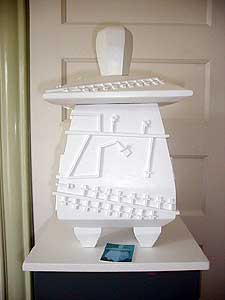|
Audio
Photos
Resources
|
May 3, 2005
Business experts say you have to find a niche to succeed. Artist Bradley Royce says he's found his niche, but he he's having a hard time finding any buyers.
St. Paul, Minn. — Bradley Royce makes urns. They're funerary urns, used for keeping a loved one's ashes. His urns are rather large, made of wood and painted a stark white; Royce says it reminds him of bleached-out bones.
Some bear complex relief patterns on their sides, others are quite simple. The urns are thick and squat, primitive while at the same time evoking images of Japanese pagodas. Royce loves them all.
"It's got everything. It's like a Cecil B. DeMille movie," says Royce. "It's got three dimensions, collage, painting -- the whole works. So it's got everything to make me happy working on it."
Royce is a big grizzly bear of a man, wearing a work shirt and suspenders. When he speaks of his urns, it's with a passion and affection that appears to surprise even himself.
Royce started working on wooden boxes about four years ago. At first he couldn't figure out what he was making, but he felt they were significant, not just artsy containers for office supplies.
"So I thought, well, these are like cremation urns. These are important enough for somebody that when they're dead and burnt to ash they can be put in this thing and it would not be demeaning. It would be a very positive thing for ashes to be put into them," says Royce.
Royce has been making urns for two and a half years now. He's been working on them full time since he was fired from a job last fall. They each take about a week to make and cost anywhere from $250-$750. Royce shows his work, along with his wife's paintings, on the first floor of their house, which they've converted into a gallery. He has a Web site, too.
But in all this time he's only sold one urn -- for a friend's father.
Royce says he's looked into advertising his work, but with little success. He's taken small business courses, and learned about marketing, but he doesn't feel comfortable trying to convince someone that they should buy one of his urns. He says that's up to them.
Royce has visited dozens of Web sites selling urns online, sites like afterlifeurns.com and urnXpress.com. Each Web site offers hundreds of different mass-produced urns, from small cloisonne pots to bronze statues to wooden boxes.
"I was talking with a woman who has these things produced in the far east, has it all outsourced," says Royce. "She told me 'I'm sorry - I like your urns, but you can't make urns in the United States anymore. It's just too expensive.'"
Still Royce thinks his urns have more integrity. He just needs to find people who want to use them.
Royce says sometimes an urn is just a holding place for ashes until the family figures out what it wants to do with them. He says he's saddened to hear stories of ashes put in cardboard boxes and tucked away in closets for years before finding a final resting place.
Springboard for the Arts is a Minnesota organization dedicated to helping artists find the resources they need to succeed. Executive Director Laura Zabel says Royce's situation is common.
"The most important thing about marketing any art is exactly what his challenge has been -- finding people who care about what you do," says Zabel. "And I think there are always people out there; it's just a matter of finding them."
After looking at Royce's Web site, Zabel says she thinks he might want to try having his work shown in more established art galleries. The urns would still be urns, but galleries would expose them to an audience that has more artistic tastes. Zabel says that includes other artists.
"Artists are interested in each other's work, and are sometimes the early adopters of ideas like this," says Zabel. "So I wonder [what would happen] if he marketed to some others artists who might be interested in living inside a work of art in perpetuity."
Whether or not he finds a market for his urns, artist Bradley Royce says he's only just begun to tap the infinite permutations possible. He doesn't see himself stopping anytime soon.








